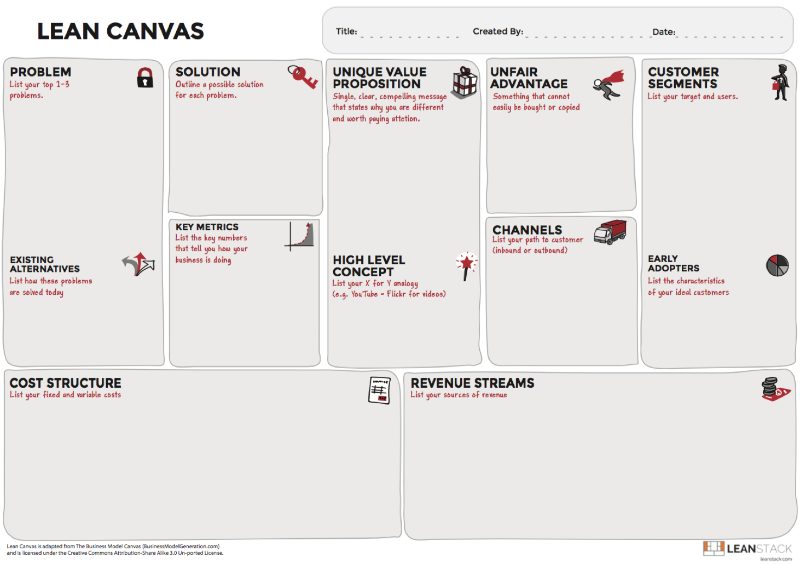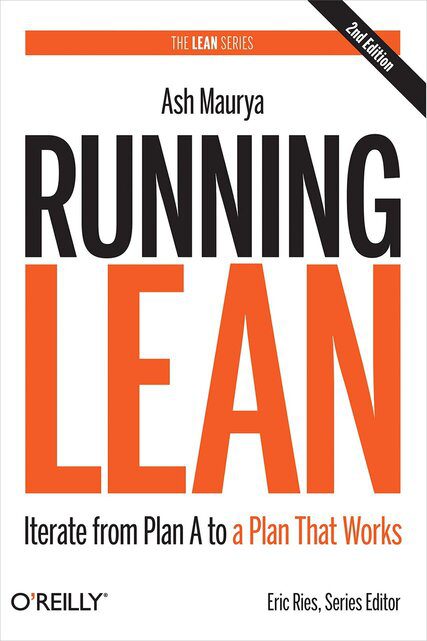In Running Lean, Entrepreneur and creator of the one-page business modeling tool “Lean Canvas“, Ash Maurya provides a step-by-step blueprint for practicing entrepreneurs who want to increase their odds of success. A business plan rests on a series of leap-of-faith assumptions, each of which can be tested empirically. Running Lean lays out Ash’s approach to breaking these assumptions down so that they can become the subjects of rigorous experiments.
“Running Lean is a systematic process for iterating from Plan A to a plan that works, before running out of resources.”
Running Lean references an array of methodologies and thinkers. Three of the most important follow :
Customer Development
Customer Development is a term coined by Steve Blank and is used to describe the parallel process of building a continuous feedback loop with customers throughout the product development cycle. It is defined in his book, The Four Steps to the Epiphany.
The key takeaway from Customer Development can best be summed up as:
Get out of the building. —Steve Blank
Most of the answers lie outside the building—not on your computer, or in the lab. You have to get out and directly engage customers.
Lean Startup
Lean Startup is a term trademarked by Eric Ries and represents a synthesis of Customer Development, Agile Software Development methodologies, and Lean (as in the Toyota Production System) practices. The term Lean is often misunderstood as “being cheap.” While “being Lean” is fundamentally about eliminating waste or being efficient with resources, that interpretation is not completely misguided because money happens to be one of those resources.
However, in a Lean Startup, we strive to optimize the utilization of our scarcest resource, which is time. Specifically, our objective is maximizing learning (about customers) per unit time. The key takeaway from Lean Startup can best be summed up around the concept of using smaller, faster iterations for testing a vision.
Startups that succeed are those that manage to iterate enough times before running out of resources.—Eric Ries
Bootstrapping
Bootstrapping is more commonly understood as a collection of techniques used to minimize the amount of external debt or funding needed from banks or investors. Too often, people confuse bootstrapping with self-funding. A stricter definition is funding with customer revenues.
Startups are inherently chaotic, but at any given point in time, there are only a few key actions that matter. You need to just focus on those and ignore the rest.
The essence of Running Lean can be distilled into three steps:
- Document your Plan A.
- Identify the riskiest parts of your plan.
- Systematically test your plan.
Step 1: Document Your Plan A
All men dream: but not equally. Those that dream by night in the dusty recesses of their minds wake in the day to find that it was vanity: but the dreamers of the day are dangerous men, for they may act their dreams with open eyes, to make it possible.—T.E. Lawrence, Lawrence of Arabia
Everyone gets hit by ideas when they least expect them (in the shower, while driving, etc.). Most people ignore them. Entrepreneurs choose to act on them. While passion and determination are attributes that are essential in order to drive a vision to its full potential, if they are left unchecked, they can also turn the journey into a faith-based one driven by dogma.
Reasonably smart people can rationalize anything, but entrepreneurs are especially gifted at this. Most entrepreneurs start with a strong initial vision and a Plan A for realizing that vision. Unfortunately, most Plan A’s don’t work.
Facts not Faith
While a strong vision is required to create a mantra and make meaning, a Lean Startup strives to uphold a strong vision with facts, not faith. It is important to accept that your initial vision is built largely on untested assumptions (or hypotheses). Running Lean helps you systematically test and refine that initial vision.
Waste is any human activity which absorbs resources but creates no value.—James P. Womak and Daniel T. Jones, Lean Thinking
The Lean Canvas
Lean Canvas is Ash Maurya’s adaptation of Alex Osterwalder’s Business Model Canvas, which he describes in the book Business Model Generation. Lean Canvas helps deconstruct your business model into nine distinct subparts that are then systematically tested, in order of highest to lowest risk. Lean Canvas is a business model validation tool. It’s a companion tool to this book that helps you document your business model, measure progress, and communicate learning with your internal and external stakeholders.

Lean Canvas helps deconstruct your business model into nine distinct subparts that are then systematically tested, in order of highest to lowest risk.
Lean Canvas is a 1-page business plan template that helps you deconstruct your idea into its key assumptions. It is optimized for Lean Startups and it replaces elaborate business plans with a single-page business model.
Customers don’t care about your solution. They care about their problems. —Dave McClure, 500 Startups
Step 2: Identify the Riskiest Parts of Your Plan
Customers buy from you when they trust you can solve their problems. Investors bet on you when they trust you can build a scalable business model. Startups are a risky business, and our real job as entrepreneurs is to systematically de-risk our startups over time. Another technique taken from the Product Development playbook is that of “tackling the riskiest parts first.” Not coincidentally, for most products, the solution isn’t what’s riskiest.
Building a successful product is fundamentally about risk mitigation.
The Three Stages of a Startup
A startup goes through three distinct stages
Stage 1: Problem/Solution Fit
Key question: Do I have a problem worth solving?
The first stage is about determining whether you have a problem worth solving before investing months or years of effort into building a solution. While ideas are cheap, acting on them is quite expensive.
A problem worth solving boils down to three questions:
- Is it something customers want? (must-have)
- Will they pay for it? If not, who will? (viable)
- Can it be solved? (feasible)
Stage 2: Product/Market Fit
Key question: Have I built something people want?
Once you have a problem worth solving and your MVP has been built, you then test how well your solution solves the problem. In other words, you measure whether you have built something people want. Achieving traction or product/market fit is the first significant milestone for a startup. At this stage, you have a plan that is starting to work—you are signing up customers, retaining them, and getting paid.
Stage 3: Scale
Key question: How do I accelerate growth?
After product/market fit, some level of success is almost always guaranteed. Your focus at this stage shifts toward growth, or scaling your business model.
Pivoting
Pivot is a term used by Eric Ries to describe a change in direction of a startup while staying grounded in learning. The best way to differentiate pivots from optimizations is that pivots are about finding a plan that works, while optimizations are about accelerating that plan.
In a pivot experiment, you attempt to validate parts of the business model hypotheses in order to find a plan that works. In an optimization experiment, you attempt to refine parts of the business model hypotheses in order to accelerate a working plan. The goal of the first is a course correction (or a pivot). The goal of the second is efficiency (or scale).
Step 3: Systematically Test Your Plan
With your Plan A documented and your starting risks prioritized, you are now ready to systematically test your plan. In a Lean Startup, this is done by running a series of experiments. The Lean Startup methodology is strongly rooted in the scientific method, and running experiments is a key activity.
Unique Value Proposition: Why you are different and worth buying getting attention.
The UVP is still hard to get right because you have to distill the essence of your product in a few words that can fit in the headline of your landing page. Additionally, your UVP also needs to be different, and that difference needs to matter. The good news is that you don’t have to get this perfect right away. Like everything on the canvas, you start with a best guess and iterate from there.
Instant Clarity Headline = End Result Customer Wants + Specific Period of Time + Address the Objections
The Pirate Metrics
Acquisition
Acquisition describes the point when you turn an unaware visitor into an interested prospect. On a product website, getting someone to do anything other than leave your website (abandon) is a measure of acquisition.
Activation
Activation describes the point when the interested customer has his first gratifying user experience.
Retention
Retention measures “repeated use” and/or engagement with your product.
Revenue
Revenue measures the events that get you paid.
Referral
Referral is a more advanced form of a user acquisition channel where your happy customers refer or drive potential prospects into your conversion funnel.
If you have a lot of uncertainty now, you don’t need much data to reduce uncertainty significantly. When you have a lot of certainty already, then you need a lot of data to reduce uncertainty significantly. —Douglas Hubbard
Continuous Deployment
Continuous Deployment is a practice of releasing software continuously throughout the day—in minutes versus days, weeks, or months. Continuous Deployment is built on continuous flow techniques that were developed at Toyota. Continuous flow has been shown to boost productivity by rearranging manufacturing processes so that products are built end to-end, one at a time, versus the more prevalent batch-and-queue approach.
The goal is to eliminate waste. The biggest waste in manufacturing is created from having to transport products from one place to another. The biggest waste in software is created from waiting for software as it moves from one state to another: “waiting to code, waiting to test, waiting to deploy. Reducing or eliminating these wait times leads to faster iterations, which is the key to success.”
In a great market, a market with lots of real potential customers, the market pulls the product out of the startup.—Marc Andreessen, “The Pmarca Guide to Startups”
Tools
- Download the Lean Canvas PDF template
- Lean Canvas: business model validation software (http://leancanvas.com)
- USERcycle: customer lifecycle management software (http://usercycle.com)
- User Testing: online usability testing (http://usertesting.com)
- KISSmetrics: actionable web analytics software (http://kissmetrics.com)
- Mixpanel: real-time event tracking (http://mixpanel.com)
- SnapEngage: online customer feedback tool (http://snapengage.com)
- Heroku: Ruby Platform-as-a-Service infrastructure (http://heroku.com)
Books
- The Lean Startup by Eric Ries (Crown Business)
- The Four Steps to the Epiphany by Steve Blank (http://www.cafepress.com/kandsranch)
- Business Model Generation by Alex Osterwalder (Wiley)
- The Entrepreneur’s Guide to Customer Development by Brant Cooper and Patrick Vlaskovits (Cooper-Vlaskovits)
- Positioning: The Battle for Your Mind by Jack Trout and Al Ries (Warner Books)
- Don’t Just Roll the Dice by Neil Davidson (Red Gate Books)
- Rocket Surgery Made Easy by Steve Krug (New Riders Press)
- Inbound Marketing by Dharmesh Shah and Brian Halligan (Wiley)
- The Principles of Product Development Flow by Donald Reinertsen (Celeritas Publishing)
- Lean Software Development: An Agile Toolkit by Mary Poppendieck and Tom Poppendieck (Addison-Wesley Professional)
All the Best in your quest to get Better. Don’t Settle: Live with Passion.



Comments are closed.